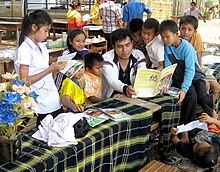
Back تعلم غير نظامي Arabic উপানুষ্ঠানিক শিক্ষা Bengali/Bangla Educació no formal Catalan Neformální vzdělávání Czech Educación no formal Spanish Mitteformaalne õppimine Estonian Hezkuntza ez-arautu Basque Epävirallinen oppiminen Finnish निरौपचारिक शिक्षा Hindi Pendidikan nonformal ID

Non-formal learning includes various structured learning situations which do not either have the level of curriculum, syllabus, accreditation and certification associated with 'formal learning', but have more structure than that associated with 'informal learning', which typically take place naturally and spontaneously as part of other activities. These form the three styles of learning recognised and supported by the OECD.[1]
Examples of non-formal learning include swimming sessions for toddlers, community-based sports programs, and programs developed by organisations such as the Boy Scouts, the Girl Guides, community or non-credit adult education courses, sports or fitness programs, professional conference style seminars, and continuing professional development.[2] The learner's objectives may be to increase skills and knowledge, as well as to experience the emotional rewards associated with increased love for a subject or increased passion for learning.[3]
- ^ "Recognition of Non-formal and Informal Learning - Home". OECD.
- ^ Eaton, Sarah Elaine (22 May 2011). "Formal, Non-Formal and Informal Learning". Archived from the original on 30 January 2017. Retrieved 23 May 2011.
- ^ "Quality guide to non-formal and informal learning processes" (PDF). 2004. Archived from the original (PDF) on 14 December 2010. Retrieved 4 October 2010.
© MMXXIII Rich X Search. We shall prevail. All rights reserved. Rich X Search